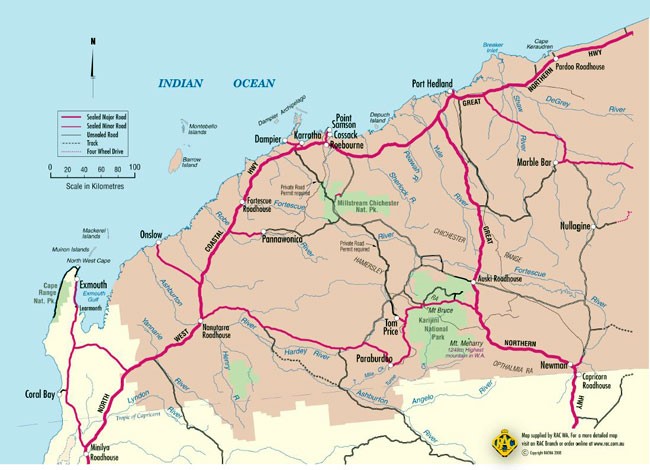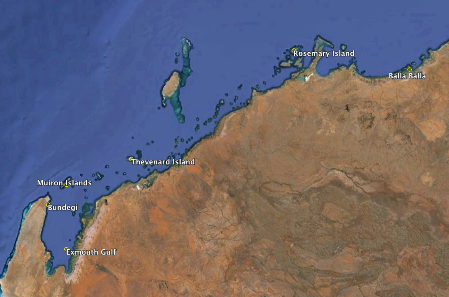Tropical North Coast

The Northern Region extends from the Ashburton River near Onslow to the NT border. The area is typified by a coastline of low sandy cliffs and vast tidal foreshores. The large tidal range can cause big currents in some areas and poor visibility in areas with soft sediment seabed. While the area has a number of moderately large regional mining centres, many coastal sites are remote and inaccessible, even by four wheel drive vehicles.
The large archipelagos of offshore islands dotting the coast enjoy better visibility as they are remote from the outflows of large rivers like the Ord and Fitzroy Rivers. They are hard to get to, but noted for clear waters and pristine reefs. Cyclones are quite common in the summer but the winter dry lasts longer than in the far north.
Onslow
Mackerels group

Of the 10 islands that make up the Mackerels group only two provide accommodation, Thevenard Island and Direction Island. Diving on Mackerel Islands is based around Thevenard Island which lies 20 kms offshore from Onslow and currently has the facilities to handle divers and snorkellers. It might be a case of use it or lose it though, as it mostly caters for oil workers and fishermen at the moment. Access is by charter boat, charter aircraft or private boat. If you were expecting palm trees and poolside cocktail lounges, forget it. The Thevenard Islands are typical of the offshore island in the region, stark red sandy shorelines with hardy low shrubs and a hot dry climate. Club Thevenard is an ex-mining camp, the facilities are basic but comfortable and the food filling. Thevenard Island is surrounded by oil infrastructure but is still a very natural wilderness, a refuge for wildlife including nesting turtles. It’s not a luxury resort, but a remote adventure location with comforts, in a world with less adventure every day. The pristine character of the reefs and the abundant fish life are the main attractions. Many close sites to the island have shallow, protected bays with large coral outcrops.You are also away from the poor visibility of the inshore coastal rivers, but not always. From time to time the area can suffer from moderate to poor visibility, averaging 12m to 15m. Winds and currents can be very strong around the islands.. If vis is poor, stick it out, its well worth the wait. The winds around the Mackerel Islands tend to be strong in the morning then drop off to dead calm by lunch time.

Black Flag
10-17M
This feature has been rated as the best dive site in the Mackerel Islands. The fish life is great with snapper, batfish, baitfish, silver drummer, groper, sweetlips, emperor, coral trout, coral cod, rock cod, tuskfish, thread-fin pearl perch, mackerel, barracuda, angelfish, mangrove jacks, bullseyes, cardinalfish and trevally. It also boats plenty of structure with caves, ledges, canyons and swim-throughs. The invertebrate life along the ledges includes large gorgonians, nudibranchs, sponges, hard corals and black coral trees. The bigger fauna includes olive sea snakes, groper, bull sharks, leopard shark, reef sharks, turtles, stingrays, wobbegong and nurse sharks. Basically, it’s hard to see what it doesn’t have and is considered a ‘must do’ site for the region.
Sultan’s Reef
6-14M
A site is a large reef just a short distance north east of Thevenard Island. The top of the reef in the coral shallows features lots of small reef fish and invertebrates. Over the edge of the reef there is a long wall covered in corals and patrolled by mackerel and barracuda. In good conditions it is an excellent dive.
Trap Reef
3-13M
This reef offers wide area of small caves and crevices with lots of colourful soft and hard coral, The fish life includes pomfreys, Spanish flag, octopus, rock cods, coral trout, gropers, trevally, sweetlips, snapper, Chinamen fish, turtles, reef sharks, thread-fin pearl perch and mangrove jack. The reef also offers colourful corals, sponges, hydroids, ascidians, nudibranchs and gorgonians.
Rankin Road
16-20M
Around 5 nautical miles from Thevenard Island a ridge-like reef is well known for large numbers of fish, including Rankin Cod. This rocky ridge is packed with baitfish, gropers, reef sharks, trevally, queenfish, sweetlips, snapper, rock cod,stingrays and sea snakes, Coral Trout, angelfish, batfish, stingrays and mackerel. There are strong currents around the reef and it needs to be dived at slack water. It it considered one of the best dives in the region.
Bessiers Island
12 to 19M
This spot off the northwest end of the island offers great coral ridges and bommies, with schooling fish. Fish life includes, gropers, reef sharks, turtles, giant potato cod, cardinalfish,batfish, moray eel, coral trout, red emperor, coral cod, rankin cod and several estuary gropers. The fish are not timid and large cod and turtles will approach closely.
Brewis Reef
4-9M
This site offers varied coral heads in shallow water with plenty of fish life. There are also caves, arches and ledges with soft corals, sponges and gorgonians. And milling around them are schools of stripy snapper, sweetlips and fusiliers.
Direction Island
1-3M
The shallow waters surrounding Direction Island offer colourful reef fish and beautiful coral formations. Snorkellers will find a fringing reef alive with fish.coral.
Thevenard Pier
3-4M
The pylons of this short pier are decorated with gorgonians and hard corals and are good for photography with shrimps, crabs, cowries, lionfish, anemones and many small reef fish.
Great Australian Bight
5-8M
This site is on the southern side of Thevenard Island consists of coral bommies covered in soft corals and gorgonians. Fish life includes lionfish, trevally, tuskfish, angelfish and Chinamen snapper. Like many places on the islands it has a wide variety of colourful nudibranchs.
Rob’s Bommie
6M
These bommies are populated by schools of reef fish and colourful. Tawny nurse shark and wobbegongs can also be seen.
Greg’s Grotto
14M
Greg’s Grotto is a very worthwhile dive with a maze of ledges and caves covered in colourful corals, sponges and gorgonians. Reef fish are abundant including reef sharks, snapper, gropers, turtles, mackerel and lionfish.
Barrow Island marine park
Barrow Island Marine Management Area and Park includes most of the waterways around Barrow Island and the Lowendal Islands. Barrow Island is remote with great coral gardens unique mangrove communities and a colourful range of tropical marine animals. Barrow Island is an important breeding and nesting area for marine turtles and its waters support important coral reefs.
